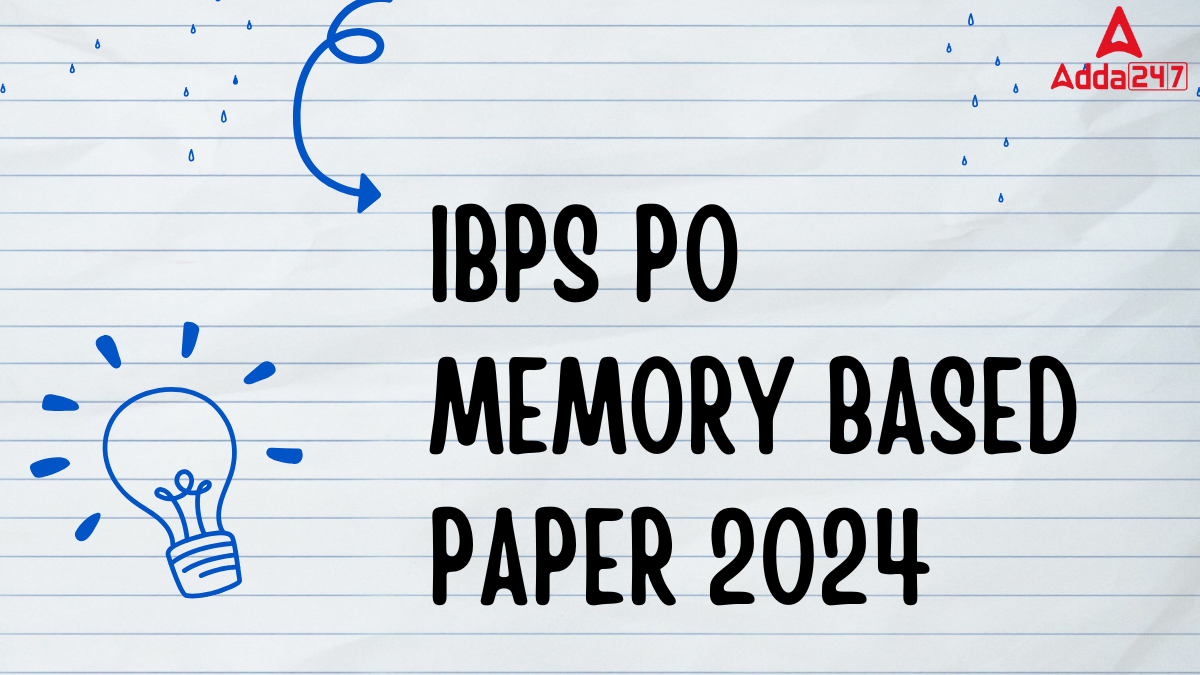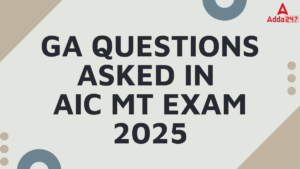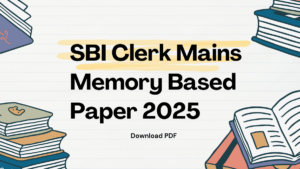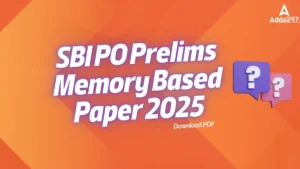Table of Contents
The IBPS PO Prelims 2024 exam is underway and for aspirants preparing for the upcoming shifts or aiming to refine their strategies, the IBPS PO Memory Based Paper 2024 is now available. This paper contains questions based on feedback from candidates who have already appeared for the exam. It serves as a valuable resource for understanding the types of questions, difficulty levels and patterns seen in the actual exam.
Schedule of IBPS PO Memory Based Paper 2024
Candidates will get the time duration to attempt IBPS PO Memory Based Paper (Based on 20 October)
- Mock Start Time: 21 October, 6:00 PM
- Mock End Time: 23 October, 12:00 PM
- Result Publish Time: 23 October, 6:00 PM
IBPS PO Memory Based Paper 2024, Attempt and Download PDF
The IBPS PO Memory Based Paper 2024 is an essential tool for candidates aiming to excel in the upcoming shifts. With a mix of online questions for immediate practice and a PDF for detailed preparation, it provides a well-rounded approach to last-minute revisions.
For a comprehensive practice experience, the full set of memory-based questions is compiled into a downloadable PDF. This PDF includes questions from all sections: Reasoning, Quantitative Aptitude and English Language, covering different difficulty levels encountered during the exam. Click the link below to download the PDF and attempt the questions at your convenience.
| IBPS PO Memory Based Mock 2024: Attempt Link | |
| Mock Based on 19 October | Click Here to Attempt |
| Mock Based on 20 October | Click Here to Attempt |
IBPS PO Prelims Memory Based 2024 PDF (English Language)
IBPS PO Prelims Memory Based 2024 PDF (Quantitative Aptitude)
IBPS PO Prelims Memory Based 2024 PDF (Reasoning Ability)
Candidates can solve these to evaluate their understanding and preparation level. Practicing these questions can also help fine-tune strategies for the next shifts by identifying gaps and strengthening weaker areas.
IBPS PO Memory Based Questions
Directions (1-5): Study the following information carefully and answer the given questions:
Seven persons A, B, C, D, E, F and G are sitting around a circular table, but not necessarily in the same order. Some of them face towards the centre, and some face away from the centre.
F sits third to the right of A. The immediate neighbours of A face the same direction but opposite as A. A faces the same direction as B but not towards the centre. One person sits between A and C. D sits 2nd to the left of C. E sits 2nd to the left of G and face in the same direction. F and D face opposite direction as E.
Q1. Who among the following sits second to the right of E?
(a) A
(b) D
(c) C
(d) F
(e) G
Q2. Which among the following pair of persons faces the same direction?
(a) G and C
(b) A and E
(c) E and D
(d) C and F
(e) None of these
Q3. How many persons sit between B and F (counting clockwise from F)?
(a) One
(b) Three
(c) Four
(d) Two
(e) None
Q4. Four of the following five persons are alike in a certain way based on their seating arrangement. Find the odd one.
(a) F
(b) C
(c) B
(d) D
(e) A
Q5. Which among the following statements is/are true?
- G faces towards the centre.
- Both F and A face away from the centre.
III. Two persons sit between C and D when counted clockwise from D.
(a) Only I
(b) Only III
(c) Both I and II
(d) Both II and III
(e) All I, II, and III
Q6. In the following questions, few sentences are given. Identify the sentences that are grammatically and contextually correct.
In the following questions, a few sentences are given. Identify the sentences that are grammatically and contextually correct.
(I) The team has worked really hard and deserves all of the praise they are receiving.
(II) She was excited to start her new job, but her nervousness was affecting her confidence.
(III) Each of the students were required to submit their projects before the deadline.
(a) Only (I)
(b) Both (II) and (III)
(c) Only (III)
(d) Both (I) and (II)
(e) All (I), (II), and (III)
Q7. In the following questions, a few sentences are given. Identify the sentences that are grammatically and contextually incorrect.
(I) The manager, along with her team, were discussing the upcoming project in great detail.
(II) If I would have known about the event earlier, I would have definitely attended it.
(III) The city has experienced a significant drop in crime rates, largely due to new safety measures implemented last year.
(a) Only (I)
(b) Both (II) and (III)
(c) Only (III)
(d) Both (I) and (II)
(e) All (I), (II), and (III)
Q8. In the following questions, a few sentences are given. Identify the sentences that are grammatically and contextually correct.
(I) If you would have studied harder, you could have passed the exam.
(II) Despite the rain, the outdoor event went on as planned, attracting a large crowd.
(III) The company’s profits have been steadily increasing due to its new marketing strategy.
(a) Only (I)
(b) Both (II) and (III)
(c) Only (III)
(d) Both (I) and (II)
(e) All (I), (II), and (III)
Directions (9-13): Read the following table carefully and answer the questions given below. The table shows the total number of bikes sold by two (X and Y) different companies in four (K, L, M, and N) different cities and the total number of cars sold by these two companies in these cities. The table also shows the total number of bikes sold by company Y in these cities.
| Cities | Bikes sold by (X and Y) | Cars sold by
(X and Y) |
Bikes sold by Y |
| K | 328 | 450 | 210 |
| L | 560 | 980 | 320 |
| M | 440 | 730 | 90 |
| N | 620 | 350 | 195 |
Q9. If total number of cars sold by Y in city K are two-fifth of the total number of bikes sold by Y in city K, then find the difference between the total number of cars sold by X in city K and bikes sold by X in city M.
(a) 22
(b) 16
(c) 23
(d) 15
(e) 18
Q10. Total number of cars sold by X in city N is 20% less than the total number of bikes sold by X in city M. Find the ratio of the total number of cars sold by Y in city N to the total number of bikes sold by Y in city K.
(a) 3:1
(b) 2:1
(c) 2:3
(d) 1:4
(e) 1:3
Q11. The ratio of the total number of cars sold by X to Y in city L is 3:4 respectively. Find the total number of cars sold by X in city L is how many more or less than the total number of bikes sold by Y in N.
(a) 225
(b) 210
(c) 195
(d) 145
(e) 125
Q12. The total number of bikes sold by X in city M is what percentage more or less than the total number of cars sold by X and Y together in city N?
(a) 2%
(b) 0%
(c) 5%
(d) 10%
(e) 7.5%
Q13. Total number of cars sold by Y in city M is 200 more than the total number of bikes sold by X in city L. The total number of cars sold by X in city M is what percentage of the total number of cars sold by X and Y together in city K?
(a) 64%
(b) 58%
(c) 42%
(d) 79%
(e) 82%
IBPS PO Exam Analysis 2024, 20th October 2024 Shift 1
IBPS PO Exam Analysis 2024, 20th October 2024 Shift 2
IBPS PO Exam Analysis 2024, 20th October 2024 Shift 3
IBPS PO Exam Analysis 2024, 20th October 2024 Shift 4
Why Use the IBPS PO Prelims Memory Based Paper 2024?
The memory-based paper helps candidates by:
- This gives insight into the types of questions asked across sections like Reasoning, Quantitative Aptitude and English Language.
- Highlighting the difficulty level and identifying recurring patterns.
- Allowing aspirants to practice under conditions that closely mirror the actual exam, improves time management and confidence.
IBPS PO Exam Analysis 2024, 19th October 2024 Shift 1
IBPS PO Exam Analysis 2024, 19th October 2024 Shift 2
IBPS PO Exam Analysis 2024, 19th October 2024 Shift 3
IBPS PO Exam Analysis 2024, 19th October 2024 Shift 4
How to Make the Most of the Memory-Based Paper?
- Simulate the Exam Environment: Attempt the questions with a timer to get used to time pressure.
- Analyze Your Performance: Identify the areas where you struggled and work on them before the next exam attempt.
- Compare with the Official Pattern: Check if any new topics appeared in this exam and adjust your revision strategy accordingly.
- Use it for Final Revisions: Go over the solutions and formulas used in the paper, especially for quantitative questions.
| Related Post | |
| IBPS PO Admit Card 2024 |
IBPS PO Expected Cut Off 2024 |
| IBPS PO Cut Off | IBPS PO Syllabus |
| IBPS PO Previous Year Papers |
IBPS PO Salary 2024 |





 GA Questions Asked in AIC MT Exam 2025, ...
GA Questions Asked in AIC MT Exam 2025, ...
 SBI Clerk Mains Memory Based Paper 2025,...
SBI Clerk Mains Memory Based Paper 2025,...
 SBI PO Prelims Memory Based Paper 2025, ...
SBI PO Prelims Memory Based Paper 2025, ...




